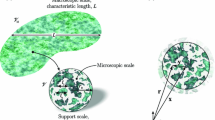Abstract
A generalization of the theory of chemical transformation processes under turbulent mixing of reactants and arbitrary values of the rate of molecular reactions is presented that was previously developed for the variant of an instantaneous reaction [13]. The use of the features of instantaneous reactions when considering the general case, namely, the introduction of the concept of effective reaction for the reactant volumes and writing a closing conservation equation for these volumes, became possible due to the partition of the whole amount of reactants into “active” and “passive” classes; the reactants of the first class are not mixed and react by the mechanism of instantaneous reactions, while the reactants of the second class approach each other only through molecular diffusion, and therefore their contribution to the reaction process can be neglected. The physical mechanism of reaction for the limit regime of an ideal mixing reactor (IMR) is revealed and described. Although formally the reaction rate in this regime depends on the concentration of passive fractions of the reactants, according to the theory presented, the true (hidden) mechanism of the reaction is associated only with the reaction of the active fractions of the reactants with vanishingly small concentration in the volume of the reactor. It is shown that the rate constant of fast chemical reactions can be evaluated when the mixing intensity of reactants is much less than that needed to reach the mixing conditions in an IMR.
Similar content being viewed by others
References
B. H. Robinson, Rapid Flow Methods, Techniques of Chemistry (Wiley, New York, 1986).
C. Kalidas, Chemical Kinetic Methods. Principles of Fast Reaction Techniques and Applications (New Age Int., New Delhi, 2005).
R. I. Kuznetsov and S. A. Sabel’nikov, Turbulence and Combustion (Nauka, Moscow, 1983) [in Russian].
Prediction Methods for Turbulent Flows, Ed. by W. Kollman (McGraw Hill, New York, 1980; Mir, Moscow, 1984).
R. W. Bilger, in Turbulent Reacting Flows, Ed. by P. A. Libby and F. A. Williams, (Springer, Berlin, 1980), p. 65.
Turbulent Reacting Flows, Ed. by P. A. Libby and F. A. Williams (Academic, New York, 1994).
S. B. Pope, in Advances in Turbulence X, Ed. by H. I. Andersson and P.-A. Krogstad (CIMNE, 2004), p. 529.
R. W. Bilger, S. B. Pope, K. N. C. Bray, and J. F. Driscoll, Proc. Combust. Inst. 30, 21 (2005).
J. Warnatz, U. Maas, and R. Dibba, Combustion. Physical and Chemical Aspects, Modeling, Experiments, Formation of Pollutants (Springer, Berlin, 2001; Fizmatlit, Moscow, 2006).
S. P. Burke and T. E. W. Schumann, Ind. Eng. Chem. 20, 998 (1928).
N. Peters, Prog. Energy Combust. Sci. 10, 319 (1984).
S. Mitarai, G. Kosaly, and J. J. Riley, Combust. Flame 137, 306 (2004).
V. P. Vorotilin and Yu. G. Yanovskii, J. Exp. Theor. Phys. 121, 145 (2015).
Author information
Authors and Affiliations
Corresponding author
Additional information
Original Russian Text © V.P. Vorotilin, 2017, published in Zhurnal Eksperimental’noi i Teoreticheskoi Fiziki, 2017, Vol. 151, No. 1, pp. 199–209.
Rights and permissions
About this article
Cite this article
Vorotilin, V.P. On the mechanism of effective chemical reactions with turbulent mixing of reactants and finite rate of molecular reactions. J. Exp. Theor. Phys. 124, 172–181 (2017). https://doi.org/10.1134/S1063776116130124
Received:
Published:
Issue Date:
DOI: https://doi.org/10.1134/S1063776116130124



